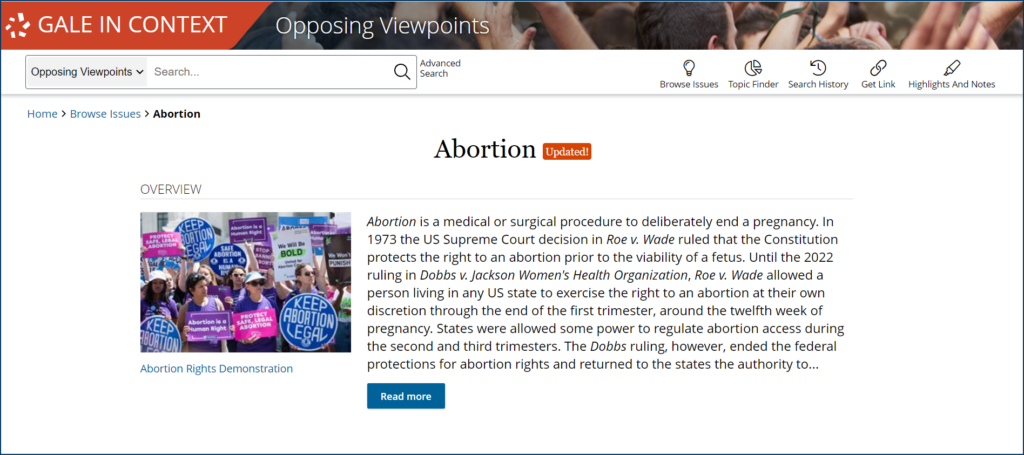| By Gale Staff |
It can be nerve-wracking to invite high schoolers to engage in discourse about controversial topics. You run the risk of sparking what Lee Warren of Harvard University’s Derek Bok Center for Teaching and Learning calls “hot moments.”
However, it’s our job as educators to ensure that our classrooms are safe spaces for students to work through challenging, multi-faceted quandaries by cultivating shared trust and respect. Doing so not only empowers teenagers to speak up about issues that matter to them but also models the critical thinking required to become informed citizens.
In fact, the American Bar Association calls discussions about controversial issues “the most prescribed curricular cure for an ailing democracy,” as they “strengthen democratic commitments, increase political knowledge, prepare adolescents to live in a pluralistic society, and help them discover what they believe.”
So, how can we as educators engage learners, encourage them to argue with empathy, and challenge their critical-thinking skills with reliable resources that cater to diverse learning styles?
Explore All Sides of the Issue With Gale In Context: Opposing Viewpoints
Gale In Context: Opposing Viewpoints is an authoritative, media-rich research database that invites students to dig into current events and social issues with periodical content, pro/con viewpoints, reference articles, infographics, maps, and more.
Whether you’re engaging your students in a classroom debate about the implications of artificial intelligence or asking them to write a complete argument, counterargument, and refutation essay about their stance on alternative medicine, you can integrate Opposing Viewpoints across all subject areas with content aligned to national and Common Core State standards.
The platform features a topically organized collection of unbiased content in an easy-to-use interface that supports differentiated instruction and equitable access to information with ReadSpeaker text-to-speech technology, article translation in 20 languages, and Lexile range search filters. Students will also appreciate how easy it is to find exactly what they’re looking for and related content they may not have considered yet.
Let’s look at two issues featured on Gale In Context: Opposing Viewpoints and how the platform prepares students to participate in well-informed, empathetic civic engagement.
Self-Driving Cars: Teach Students Savvy Consumerism
Getting a driver’s license is one of the most exciting rites of passage for many teenagers. But with the advent of self-driving cars, it’s not hard to imagine that road tests may someday become obsolete as AI technology uses algorithms to take the wheel.
There’s a sense of inevitability around self-driving cars. Eventual widespread use is not a matter of if, but when. Projections show that the number of autonomous vehicles used globally will grow from 16,960 in 2022 to 125,660 in 2030—a 640% increase in less than a decade.
Current high schoolers could soon be facing a major buying decision beyond make, model, and color: Should they opt for self-driving technology, or does road safety require the human touch?
Activity Idea: Would You Automate Your Automobile?
Automated vehicles present an opportunity to hone your students’ research skills while teaching them consumer habits that cut through increasingly persuasive (and invasive) marketing practices.
With Opposing Viewpoints, students can start with the topic overview that covers the history of self-driving cars, legislation, and a summary of pro/con arguments.
From there, you can discuss how informed consumers compare multiple products or perspectives using online reviews, news articles, as well as conversations with friends and family. For your classroom discussion, your students can replicate this process by perusing the plethora of facts, figures, and viewpoints available through the Opposing Viewpoints portal, some of which include:
- Self-driving vehicles can theoretically make life-saving traffic decisions based on data and machine learning rather than emotion or reflex.
- Automation technology could give people with disabilities the opportunity to drive again.
- Interest in vehicle purchases has been waning since 2008, while tech-based transportation services like Uber have been booming.
As they gather evidence, ask them to take notes on what they learn so they can justify their final “purchase decision.”
Cross-Curriculum Connections
Once students have decided whether they would opt for a traditional or automated vehicle, ask them to choose a specific car and track the cost over ten years based on the initial purchase price, insurance estimates, gas, taxes, etc. This activity is excellent practice for purchasing a car in real life—whether self-driving or not!
Dobb’s v. Jackson Women’s Health Organization: Prepare to Participate in the Democratic Process
There’s no tiptoeing around the fact that abortion is a reality that some of our students will face personally.
Teenage pregnancy hit an all-time low in the United States in 2022, down to 13.5 pregnancies per 1,000 young women aged 15-19, continuing a trend dating to 1991, when the rate was when the rate was four times higher. The overall abortion rate has also declined, from 85 per 1,000 women in 1991 to 5.5 per 1,000 in 2020.
In 2022, the case of Dobb’s v. Jackson Women’s Health Organization overturned Roe v. Wade’s federal protection of the procedure during the first trimester and left the question of abortion in the hands of individual states for the first time since 1973.
The states have vastly different definitions of their abortion laws. State legislators who oppose abortion have struggled to determine what exceptions (if any) should be allowed, particularly in cases of rape, incest, or medical necessity—such as ectopic pregnancies or a cancer diagnosis that requires chemotherapy.
Some states, like South Carolina, have passed abortion bans, but they still have exceptions in place for the circumstances mentioned above. By contrast, Texas’s S.B. 8 prohibits all abortions after six weeks under all circumstances, though recent provisions were added for ectopic pregnancies and premature membrane ruptures.
Your students will soon be making choices about where to attend college or find work, and it’s critical that they understand what reproductive rights they have (or don’t have) depending on where they choose to live. Jumping directly into a Socratic seminar about each student’s beliefs on these laws would be too much, too soon. Instead, you can leverage the resources available in Gale In Context: Opposing Viewpoints to facilitate a debate that encourages students to conduct both qualitative and quantitative research, understand differing points of view, and model respectful civic engagement.
Activity Idea: Research and Roleplay
Start by splitting your class into small groups, each with an assigned region of the United States. As they get started, provide them with access to the research toolkit, available on the Educator Resources page. They’ll use these scaffolding tools and the Opposing Viewpoints’ abortion portal page to search for information about post-Dobbs v. Jackson Women’s Health Organization legislation in each state in that region.
Next, each group will use their findings to create a visual representation of legislation—such as a color-coded map or digital infographic—to summarize the abortion laws in those states, including recent changes and any relevant statistics from trusted sources. Encourage them to use the related topics on each resource page to learn about any abortion policies or medical terminology they may not understand.
HS_12_Visual_Representations_2020Once they’ve created their visual presentations, each group will share their findings with the class. Leave room for a brief Q&A section to clarify any points, but NOT to argue their views about the information. Listen closely for signs your students can clarify and question while respecting all parties’ viewpoints.
After the presentations, instruct your students to dig deeper into a state law they find particularly interesting or compelling. They’ll want to focus on evidence that helps them debate the point from the perspective of a legislator, healthcare professional, or citizen. You can use the essential questions from Gale In Context: Opposing Viewpoints to guide this work:
- What factors do you think prevented federal lawmakers from adding a constitutional amendment or passing a federal law establishing a national standard regarding abortion rights?
- Under what circumstances, if any, do you think state governments should restrict a person’s access to abortion services? Explain your answer.
- How has the Supreme Court’s 2022 overturning of abortion rights affected abortion access in the country? What do you consider to be the most significant effect of those changes?
From there, you can use your discretion to decide whether your students have the necessary understanding of the rules of engagement to share their argument verbally or if they need more explicit instruction in respectful debate. The Center for Research on Learning & Teaching at the University of Michigan has a comprehensive resource on the Guidelines for Discussing Difficult or High-Stakes Topics that would help establish norms.
Enriching the Conversation
If you feel your learners are ready for an even more challenging critical thinking exercise, let them choose from a selection of “alternative angles” that connect abortion with other topics available in the Gale In Context: Opposing Viewpoints platform.
Examples include:
- How does access to contraceptives impact the abortion rates?
- How does sex education in high school affect the abortion rate?
- Is there a relationship between minimum wage and abortion rates?
- On a global scale, is there a relationship between abortion rates in a particular country and the laws about paid parental leave?
Teaching Our Students How to Think About Tough Topics
We have a unique opportunity to teach the teenagers in our classrooms how to engage in thoughtful, respectful civil discourse supported by trusted sources of evidence from diverse perspectives.
Unfortunately, while technology makes it much easier to tap into a vast number of different resources and opinions with a simple search, we know that quantity isn’t nearly as important as quality. This access to unfiltered, unvetted information can easily land our learners in an online echo chamber that reinforces existing biases and limits their exposure to the full spectrum of perspectives.
The Gale In Context: Opposing Viewpoints platform fights back against misinformation and one-sided points of view by offering a thoroughly vetted resource that represents diverse perspectives without presenting either side as right or wrong. That means your learners can formulate their own opinions while developing critical thinking and research skills that will empower them to be engaged, informed citizens long after they leave your classroom.
If you’re not yet a subscriber, learn more about the benefits of Gale In Context: Opposing Viewpoints!



